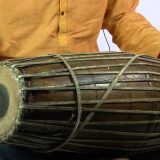Saareeraka Upanishad~8(A)
SriSaaradaa Vaatsalya Sphoortih :—
17—01—2018; Wednesday.
Saareeraka Upanishad — 8(A).
Now we are going to discuss regarding certain grammatical implication on which Sri Kiran Sundar, B., sought some clarification and then regarding the ‘sense of sound’ in the earth-element, as intended by Smt. B. Sahiti, both of whom are from Chennai.
1). Almost all the Upanishadic texts are presented in conversational Sanskrit language. Like all other languages, even in Sanskrit, the conversational version of the language has its own unique idiomatic lively flavour.
Such expressions as ‘Somya‘/’Sowmya‘, ‘Hanta‘, ‘Bata‘, ‘Ayi‘, ‘Baadham‘ are some of usual ones which are natural expressions in conversations, and are frequently found in Upanishads and Sanskrit dramas too. In the conversational dialect of Sanskrit, we find in this Upanishad, out of the five mantras in Part—8 of S.U., in the three mantras, namely, 15, 17, & 18, compounds are used.
According to the conventions of the Grammar of Sanskrit Language, the last word in a compound is declined and as such all of them are in the nominative case in the plural number in the elements of the earth and the fire while in the element of the air, it is in the dual number and in the nominative case only.
In the mantras 16 & 19, the two basic words are “ap“(feminine gender in perennial plural), and “aakaasa” (masculine/neuter gender). Both of them are non-compound words and as such they are directly declined into the appropriate possessive case.
Even in the 15th mantra, “prithivee-gunaah” is in a compound. So, the compound is declined in the nominative, as in the case of the other two.
2). Now we take up the inherence of the sense of sound in the element of the earth. For its clarification let us go to the origin or the very first element which is the space. We understood that this space is the very first and the nearest element to the Brahman, Who/Which is the eternal Source of all that is the manifest and the unmanifest. In the Bhagavad Gita, Chapter—II, we find a verse that describes the all-pervasive Supreme Brahman, which begins as:-
” Achchedyo>yam Adaahyo>yam Akledyo>soshya eva cha | Nityah Sarvagatah Sthaanuh Achalo>yam Sanaatanah ” ||
and so on and so forth. These words describe, verily, the qualities of the space-element also, in a way. That means, these descriptions of the Brahman are inherent in the space-element also which originated from the Perennial Source. The very same descriptions of the Brahman are reduced to be the perceptible qualities of the space-element as it became a primary constituent of the entire universe of which the space-time-continuum is the most fundamental substance and substratum rolled into one. Subsequently, all the qualities of the preceding elements are ingrained in all the succeeding elements, while each element holds its unique quality with which it is naturally endowed.
Let us deliberate upon the space-element first. Its unique quality is sound. Then the air-element is derived from out of the space. Now, the air possesses the unique feature of the sense of touch while retaining the sense of sound of its mother-element, the space. That is why the air imparts us the sense of touch while giving out noise when it blows. Same way, the fire has the unique character of form, with the sense of touch of heat and sense of sound of space, while burning. This very same process can be logically extended to the the remaining two elements, namely, the water as well as the earth. Consequently, the fifth and final element, the earth has all the five senses of smell, taste, form, touch and sound, including its own quality and the remaining other four qualities. That is why when we hit a stone with another one, we clearly find that sound is generated. Most of the musical instruments and the musical pillars in Rameswaram and other temples are finest demonstrations of the ingrained existence of sound in the earth-element in the super fine quality of the “Naada“. By understanding the metaphysical science propounded in the Chandogya Upanishad which is called the “Pancheekaranam“, the quintuplication procedure of the five fundamental elements, we can have a better grasp of these concepts of wonderful process of subsumption.
Swasti ||














Thank you for the clarification for my query through point no.1.
Chandogyopanishad spoke of TrivritkaraNam (only 3 elements – fire water and earth), which was extended to pancheekaraNam by Adishankara et al?.
చాలా బాగా వివరించావు.thank you so much.ఆకాశతత్వం ఎం త అద్భుతంగా వుంది! సైంటిస్ట్ లకి సైంటిస్ట్ లు కదా మన మహర్షులు.